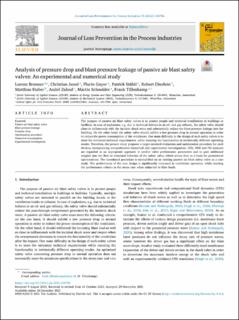Please use this identifier to cite or link to this item:
https://doi.org/10.21256/zhaw-23834Full metadata record
| DC Field | Value | Language |
|---|---|---|
| dc.contributor.author | Brenner, Lorenz | - |
| dc.contributor.author | Jenni, Christian | - |
| dc.contributor.author | Guyer, Flurin | - |
| dc.contributor.author | Stähli, Patrick | - |
| dc.contributor.author | Eberlein, Robert | - |
| dc.contributor.author | Huber, Matthias | - |
| dc.contributor.author | Zahnd, André | - |
| dc.contributor.author | Schneider, Martin Albert | - |
| dc.contributor.author | Tillenkamp, Frank | - |
| dc.date.accessioned | 2022-01-07T11:25:38Z | - |
| dc.date.available | 2022-01-07T11:25:38Z | - |
| dc.date.issued | 2021-12-18 | - |
| dc.identifier.issn | 0950-4230 | de_CH |
| dc.identifier.uri | https://digitalcollection.zhaw.ch/handle/11475/23834 | - |
| dc.description.abstract | The purpose of passive air blast safety valves is to protect people and technical installations in buildings or facilities. In case of explosions, e.g. due to technical failures in an oil- and gas refinery, the safety valve should close in milliseconds with the incident shock wave and substantially reduce the blast-pressure leakage into the building. On the other hand, the safety valve should exhibit a low pressure drop in normal operation in order to reduce the power consumption of the ventilators. One main difficulty in the design of such safety valves is to meet the minimum technical requirements, while ensuring the functionality in intrinsically different operating modes. Therefore, the present study proposes a target-oriented evaluation and optimization procedure for such devices, incorporating comprehensive numerical and experimental investigations. CFD, FEM and FSI analyses are regarded as an appropriate approach to predict valve performance parameters and to gain additional insights into the flow or structural behavior of the safety valve, which serves then as a basis for geometrical optimizations. The introduced procedure is exemplified on an existing passive air blast safety valve as a case study. The performance of the new design is significantly increased in ventilation operation, while meeting the performance criteria in the stress case when subjected to blast loads. | de_CH |
| dc.language.iso | en | de_CH |
| dc.publisher | Elsevier | de_CH |
| dc.relation.ispartof | Journal of Loss Prevention in the Process Industries | de_CH |
| dc.rights | http://creativecommons.org/licenses/by/4.0/ | de_CH |
| dc.subject | Passive air blast safety valve | de_CH |
| dc.subject | Blast pressure leakage | de_CH |
| dc.subject | Pressure drop | de_CH |
| dc.subject | Optimization procedure | de_CH |
| dc.subject | Numerical investigation | de_CH |
| dc.subject | Experimental investigation | de_CH |
| dc.subject.ddc | 620: Ingenieurwesen | de_CH |
| dc.title | Analysis of pressure drop and blast pressure leakage of passive air blast safety valves : an experimental and numerical study | de_CH |
| dc.type | Beitrag in wissenschaftlicher Zeitschrift | de_CH |
| dcterms.type | Text | de_CH |
| zhaw.departement | School of Engineering | de_CH |
| zhaw.organisationalunit | Institut für Energiesysteme und Fluid-Engineering (IEFE) | de_CH |
| zhaw.organisationalunit | Institut für Mechanische Systeme (IMES) | de_CH |
| dc.identifier.doi | 10.1016/j.jlp.2021.104706 | de_CH |
| dc.identifier.doi | 10.21256/zhaw-23834 | - |
| zhaw.funding.eu | No | de_CH |
| zhaw.originated.zhaw | Yes | de_CH |
| zhaw.pages.start | 104706 | de_CH |
| zhaw.publication.status | publishedVersion | de_CH |
| zhaw.volume | 75 | de_CH |
| zhaw.publication.review | Peer review (Publikation) | de_CH |
| zhaw.webfeed | Simulation and Optimization | de_CH |
| zhaw.funding.zhaw | Neuentwicklung eines Explosionsschutzventils | de_CH |
| zhaw.author.additional | No | de_CH |
| zhaw.display.portrait | Yes | de_CH |
| Appears in collections: | Publikationen School of Engineering | |
Files in This Item:
| File | Description | Size | Format | |
|---|---|---|---|---|
| 2021_Brenner-et-al_Analysis-of-pressure-drop-and-blast-pressure-leakage.pdf | 4.27 MB | Adobe PDF |  View/Open |
Show simple item record
Brenner, L., Jenni, C., Guyer, F., Stähli, P., Eberlein, R., Huber, M., Zahnd, A., Schneider, M. A., & Tillenkamp, F. (2021). Analysis of pressure drop and blast pressure leakage of passive air blast safety valves : an experimental and numerical study. Journal of Loss Prevention in the Process Industries, 75, 104706. https://doi.org/10.1016/j.jlp.2021.104706
Brenner, L. et al. (2021) ‘Analysis of pressure drop and blast pressure leakage of passive air blast safety valves : an experimental and numerical study’, Journal of Loss Prevention in the Process Industries, 75, p. 104706. Available at: https://doi.org/10.1016/j.jlp.2021.104706.
L. Brenner et al., “Analysis of pressure drop and blast pressure leakage of passive air blast safety valves : an experimental and numerical study,” Journal of Loss Prevention in the Process Industries, vol. 75, p. 104706, Dec. 2021, doi: 10.1016/j.jlp.2021.104706.
BRENNER, Lorenz, Christian JENNI, Flurin GUYER, Patrick STÄHLI, Robert EBERLEIN, Matthias HUBER, André ZAHND, Martin Albert SCHNEIDER und Frank TILLENKAMP, 2021. Analysis of pressure drop and blast pressure leakage of passive air blast safety valves : an experimental and numerical study. Journal of Loss Prevention in the Process Industries. 18 Dezember 2021. Bd. 75, S. 104706. DOI 10.1016/j.jlp.2021.104706
Brenner, Lorenz, Christian Jenni, Flurin Guyer, Patrick Stähli, Robert Eberlein, Matthias Huber, André Zahnd, Martin Albert Schneider, and Frank Tillenkamp. 2021. “Analysis of Pressure Drop and Blast Pressure Leakage of Passive Air Blast Safety Valves : An Experimental and Numerical Study.” Journal of Loss Prevention in the Process Industries 75 (December): 104706. https://doi.org/10.1016/j.jlp.2021.104706.
Brenner, Lorenz, et al. “Analysis of Pressure Drop and Blast Pressure Leakage of Passive Air Blast Safety Valves : An Experimental and Numerical Study.” Journal of Loss Prevention in the Process Industries, vol. 75, Dec. 2021, p. 104706, https://doi.org/10.1016/j.jlp.2021.104706.
Items in DSpace are protected by copyright, with all rights reserved, unless otherwise indicated.